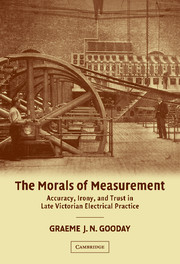Book contents
- Frontmatter
- Contents
- List of illustrations
- Abbreviations
- Preface
- 1 Moralizing Measurement: (Dis) Trust in People, Instruments, and Techniques
- 2 Meanings of Measurement and Accounts of Accuracy
- 3 Mercurial Trust and Resistive Measures: Rethinking the ‘Metals Controversy’, 1860–1894
- 4 Reading Technologies: Trust, the Embodied Instrument-User and the Visualization of Current Measurement
- 5 Coupled Problems of Self-Induction: The Unparalleled and the Unmeasurable in Alternating-Current Technology
- 6 Measurement at a Distance: Fairness, Trustworthiness, and Gender in Reading the Domestic Electrical Meter
- Conclusion
- Index
4 - Reading Technologies: Trust, the Embodied Instrument-User and the Visualization of Current Measurement
Published online by Cambridge University Press: 23 November 2009
- Frontmatter
- Contents
- List of illustrations
- Abbreviations
- Preface
- 1 Moralizing Measurement: (Dis) Trust in People, Instruments, and Techniques
- 2 Meanings of Measurement and Accounts of Accuracy
- 3 Mercurial Trust and Resistive Measures: Rethinking the ‘Metals Controversy’, 1860–1894
- 4 Reading Technologies: Trust, the Embodied Instrument-User and the Visualization of Current Measurement
- 5 Coupled Problems of Self-Induction: The Unparalleled and the Unmeasurable in Alternating-Current Technology
- 6 Measurement at a Distance: Fairness, Trustworthiness, and Gender in Reading the Domestic Electrical Meter
- Conclusion
- Index
Summary
Professor Ayrton's galvanometer will be a great help to us electric light engineers: we are greatly in want of a trustworthy galvanometer to be carried down to the various installations as we fix them.
David Chadwick, discussion at the STEE, London, 1881I myself began with great faith in the ordinary electrical instruments; but, after taking readings sometimes with one and sometimes with another instrument, I began to lose it.
Peter Willans, discussion at the IEE, London, November 1891Why did late nineteenth-century electricians decide to trust particular measurement instruments in preference to others? Was it a particular faith in the theory that informed the design of their electromagnetic mechanism? Was it their trust in the instrument-maker's effectiveness in enacting reliable designs for the devices? Or was it the fidelity with which users could take quantitative readings from performances yielded by the instrument? We need to consider these sorts of questions to recover how evaluations were made of the trustworthiness of the new species of ‘direct-reading’ current-measuring instruments that came onto the market in the 1880s. In contrast to the idealist tradition common in the history of science that treats instruments as essentially theory-laden devices, I consider measurement instruments from the perspective of users as technologies that had to be read. As in the previous chapter, my aim here is to show that pressing problems of trust were generated by the recalcitrance and fallibility of instrumental readings.
Information
- Type
- Chapter
- Information
- The Morals of MeasurementAccuracy, Irony, and Trust in Late Victorian Electrical Practice, pp. 128 - 172Publisher: Cambridge University PressPrint publication year: 2004
